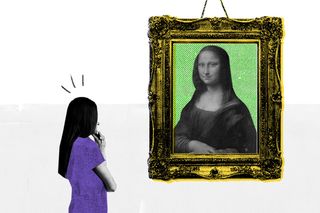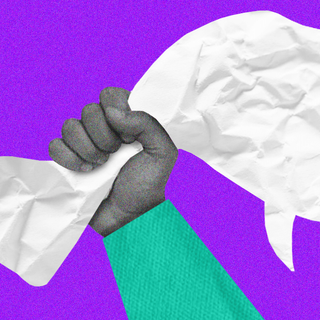
Why People Falsely Believe Something Happened – When It Didn’t
The “Mandela effect” explains how individual psyche and society can influence memories to a point that they eventually become incorrect.

Do you remember the Mona Lisasmiling? It depends on who you ask. Some would say there’s a noticeable curl to her lip, indicating some amusement. But there are people who would argue with confidence that the “Mona Lisa Smile” is a false memory.
The incoherence of reality spills beyond paintings and the degree of smile. Did the Evil Queen really say “Mirror, mirror, on the wall” in Snow White? Or was it “Magic Mirror on the wall”? Darth Vader’s cathartic reveal in Star Wars with, “Luke, I’m your father,” never quite happened. The dialogue was always “No, I am your father.” The incorrect pop-culture memory is not an exception, but a surprisingly common recurrence.
The countless instances point to a trend of people confidently, collectively misremembering an event, a quote, an image — swearing by the fact it happened, when it never did. It’s what’s called the “Mandela effect.”
The saga started in 2009 when some American researchers were discussing the South African revolutionary? Nelson Mandela’s death. They remembered seeing news coverage of him dying in a prison in the 1980s. The facts drastically differed: Mandela served 27 years in prison, was elected the president of South Africa between 1994 and 1999, and passed away in 2013. What was curious is a group of people remembering an incorrect memory in vivid detail; a collective veil of disillusion if you will. Again, in 2010, internet communities harkened to the same idea of Mandela dying in the ’80s. Paranormal consultant Fiona Broome thus coined the term “Mandela effect” — a shorthand for false memories shared by a group of people.
The Mandela effect is rife with a complex understanding of human memory and how we process events as a society. It speaks to the heart of how fallible memories are; “memories are vulnerable bits of information stored in the brain that can be changed over time. While we assume that our memories are accurate, this is not necessarily the case,” as Arlin Cuncic, who worked at the psychology department at the University of Western Ontario, noted.
There is a cluster of theories about false memories that may explain this dissonance. One school of thought speaks of “confabulation,” when the brain automatically fills in the gaps in our memories to make sense of our reality. This isn’t categorical lying, but merely the body’s attempt to cope with the knowledge gap. The mind remembers details that never happened as a response; so confabulations become retellings of events without any factual support. But the person saying this confidently regards these as facts; the memory of Mandela’s death becomes a compelling example of this.
Related on The Swaddle:
Society Idealizes Having a Great Memory. But What if It’s Better to Forget?
Then, there is the idea of “priming” that alters, ever so slightly, how we approach an event. Also called suggestibility and presupposition, priming builds on the events that lead up to an event. If we suggest the answer to someone, the likelihood is that their answer will adapt itself to fit the information just given. For instance, “Did you have chicken salad for lunch?” is more suggestive than “What did you have for lunch?”; the tangible object in the first phrase leaves behind a much stronger memory. Priming explains memory and how it responds to stimuli, again indicating its malleability with time.
False memory may also be related to the power of association. We know Alexander Hamilton is the founding father of America, but wasn’t the president. Yet, in an experiment, when researchers asked participants to list the presidents of the U.S., they included Hamilton.
Who was Alexander Hamilton? Most Americans learned in school that he was a founding father of the United States of America but that he was not a president. However, when asked about the presidents of the U.S., many people mistakenly believe that Hamilton was a president. “The memory for Alexander Hamilton is encoded in an area of the brain where the memories for the presidents of the United States are stored. The means by which memory traces are stored is called the engram and the framework in which similar memories are associated with each other is called the schema. So when people try to recall Hamilton, this sets off the neurons in close connection to each other, bringing with it the memory of the presidents,” Cuncic explained.
Arguably, memory is an ever-morphing construct for it adapts to the new information we learn. The information doesn’t have to be accurate for it to alter people’s memory; which explains why experts have often expressed concernabout the credibility of eyewitness testimony.
This trend plays out more acutely and in pernicious ways in the age of algorithms and the internet. We know falsehoods and misinformation spread like wildfire across digital channels; so the potential for a community to capitalize on misconceptions is higher. This means false events turn into reality — solely by virtue of people’s assertions — such that what was once merely fiction could turn into fact. In one experiment, researchers used a dataset of about 100,000 news stories circulating across Twitter over a period of 10 years. These stories were tweeted or retweeted by real people and not bots. The study found that news stories carrying rumors and falsehoods trumped truth every time; real people who were spreading false information because of their misplaced weight on truth and lies.
Perhaps the most thrilling — but deeply contested — reason for the Mandela effect lies in the hotly-debated scientific concept: the parallel universe. The fodder for many sci-fi movies, the idea of a parallel universe originates from quantum physics and string theory. The multiverse is a disputed territory; but the Mandela effect, Broome had hypothesized, is a result of the intersection of alternate realities. In other words, people would collectively have the same incorrect memories because of ever-shifting realities. Sure, in another universe, the animated show Looney Tunes may have figured as Looney Toons.
The mystery and excitement of an alternative universe are tempting, but the notion of a multiverse is, thus far, the most implausible explanation of why we believe falsehoods in stellar detail with certainty. To quote my colleague who was thrilled at this prospect of a parallel universe: “one can only hope.”
Saumya Kalia is an Associate Editor at The Swaddle. Her journalism and writing explore issues of social justice, digital sub-cultures, media ecosystem, literature, and memory as they cut across socio-cultural periods. You can reach her at @Saumya_Kalia.
Related


Why Most People Hold Off on Giving Constructive Feedback
